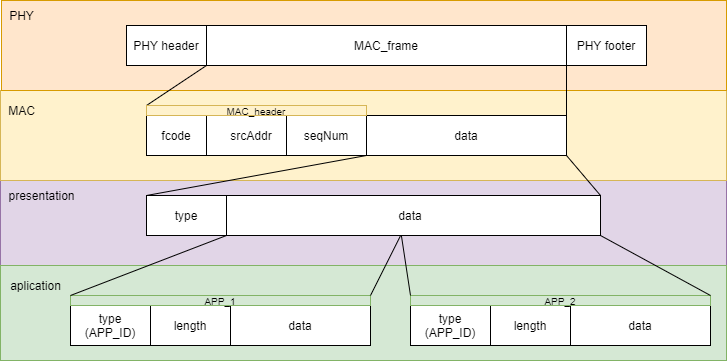UWB Frames Encapsulation
This is the latest UWB frame protocol specification compliant with Sewio infrastructure.
Requirements:
RTLS Studio: version 2.6.0 or newer
Anchor FW: version 3.1.6 or newer
Tag FW: version 3.127.7 or newer
Tag Leonardo Configurator 1.3.2 or newer
- Setting → Blink Profile = RF5
How-to
The full UWB frames contain various overhead fields which are appended as it goes from APP to PHY layer.
Sewio UWB frame encapsulation example from APP to PHY Layer
Briefly on the layers
| Physical Layer | Physical layer. The lowest layer of the system. This layer knows nothing about the content of the transmitted frame. The only information that is given to this layer is the length of the frame and the frame itself as an array of data bytes. This frame is processed by a UWB transceiver. | ||||||
| MAC Layer | MAC layer ensures the successful transfer of the frame from point A to point B. So the following fields are used by this layer:
| ||||||
| Presentation Layer | This layer act as a multiplexer. It takes the raw data from the frame and passes it to the specific application. | ||||||
| Application Layer | This is the top layer where the user payload is sent and received. |
Examples of UWB frames
The simplest blink without any application or system data
| PHY layer | MAC layer | PHY layer | ||
|---|---|---|---|---|
| PHY header | fcode | srcAddr | seqNum | PHY footer |
| (generated by DW1000) | 0xBB | 0x22035eb14066 | 0x20 | CRC16 (generated by DW1000) |
The blink with battery level
| PHY layer | MAC layer | presentation layer | APP layer | PHY layer | ||||
|---|---|---|---|---|---|---|---|---|
| PHY heade | fcode | srcAddr | seqNum | msgType | APP ID | length | APP data | PHY footer |
| (generated by DW1000) | 0xBB | 0x22035eb14066 | 0x20 | 0x64 | 0x0001 | 0x01 | 0xC8 | CRC16 (generated by DW1000) |
The blink with battery level and barometer data
| PHY layer | MAC layer | presentation layer | APP layer* | ||||
|---|---|---|---|---|---|---|---|
| PHY heade | fcode | srcAddr | seqNum | msgType | APP ID | length | APP data (battery level) |
| (generated by DW1000) | 0xBB | 0x22035eb14066 | 0x20 | 0x64 | 0x0001 (batt lvl) | 0x01 | 0xC8 |
| APP layer | PHY layer | ||
|---|---|---|---|
| APP ID | length | APP data (baro data) | PHY footer |
| 0x0005 (sensors data) | 0x05 | 0x08AABBCCDD | CRC16 (generated by DW1000) |
*at APP layer can be data from multiple application
Let's continue with layer details here:
